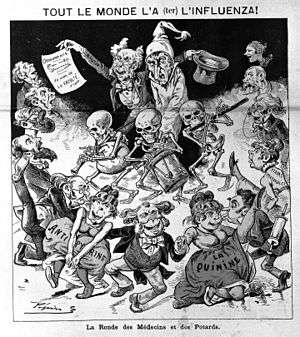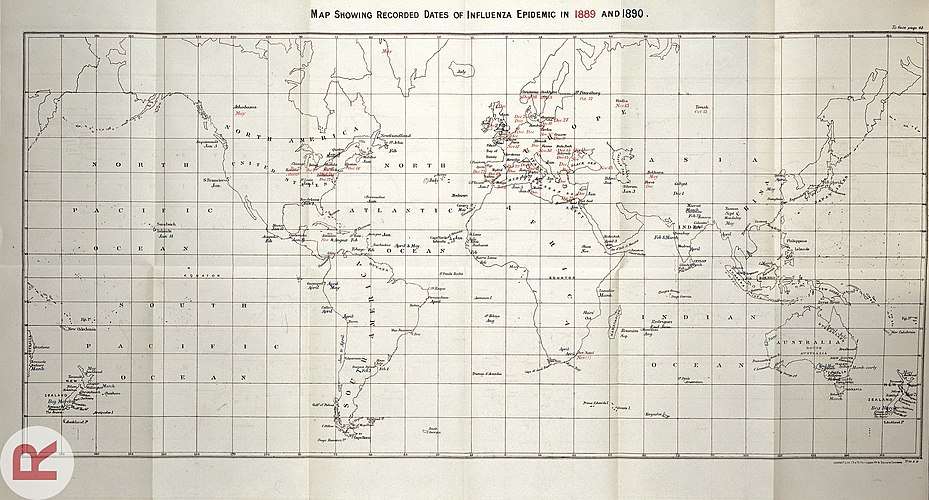1889–1890 flu pandemic
The 1889–1890 flu pandemic, also known as the "Asiatic flu" or "Russian flu", was a deadly influenza pandemic that killed about 1 million people worldwide.[1][2] It was the last great pandemic of the 19th century.[3]

The most reported effects of the pandemic took place October 1889 – December 1890, with recurrences in March – June 1891, November 1891 – June 1892, winter 1893–1894 and early 1895.
It is not known for certain what agent was responsible for the pandemic. Since 1950s it has been conjectured to be Influenza A virus subtype H2N2.[4][5][6] A 1999 seroarcheological study asserted the strain to be Influenza A virus subtype H3N8.[7] A 2005 genomic virological study says that "it is tempting to speculate" that the virus might have been not actually an influenza virus, but human coronavirus OC43.[5]
Outbreak and spread
Modern transport infrastructure assisted the spread of the 1889 influenza. The 19 largest European countries, including the Russian Empire, had 202,887 km of railroads and transatlantic travel by boat took less than six days (not significantly different than current travel time by air, given the time scale of the global spread of a pandemic).[7]
First reported in Bukhara, Russian Empire, in May 1889,[8][9][10] by November that year the epidemic had reached Saint Petersburg.[11] In four months it had spread throughout the Northern Hemisphere. Deaths peaked in Saint Petersburg on 1 December 1889, and in the United States during the week of 12 January 1890. The median time between the first reported case and peak mortality was five weeks.[7] In Malta, the Asiatic Flu took hold between January 1889 and March 1890, with a fatality rate of 4% (39 deaths), and a resurgence in January-May 1892 with 66 fatalities (3.3% case fatality).[12] When this flu began, whether it was contagious was debated, but its quick action and pervasiveness across all climates and terrains proved that it was.[10]
A result of the Asiatic flu in Malta is that influenza became for the first time a compulsorily notifiable illness.[13]
Identification of virus subtype responsible
Influenza virus
Researchers have tried for many years to identify the subtypes of Influenza A responsible for the 1889–1890, 1898–1900 and 1918 epidemics. Initially, this work was primarily based on "seroarcheology"—the detection of antibodies to influenza infection in the sera of elderly people—and it was thought that the 1889–1890 pandemic was caused by Influenza A subtype H2, the 1898–1900 epidemic by subtype H3, and the 1918 pandemic by subtype H1.[15] With the confirmation of H1N1 as the cause of the 1918 flu pandemic following identification of H1N1 antibodies in exhumed corpses,[15] reanalysis of seroarcheological data has indicated that Influenza A subtype H3 (possibly the H3N8 subtype), is a more likely cause for the 1889–1890 pandemic.[7][15]
Coronavirus
After the SARS epidemic, virologists started sequencing and comparing human and animal coronaviruses, and comparison of two virus strains in the Betacoronavirus 1 species, Bovine coronavirus and Human coronavirus OC43 indicated that they had a most recent common ancestor in the late 19th century, with several methods yielding most probable dates around 1890.[5][16] Authors speculated that an introduction of the former strain to the human population might have caused the epidemic.[5]
Notable deaths
Initial pandemic
- 1 January 1890 Henry R. Pierson
- 15 January 1890 Walker Blaine
- 22 January 1890 Adam Forepaugh
- 22 February 1890 Bill Blair
- 12 March 1890 William Allen
- 26 March 1890 Afrikan Spir
- 23 May 1890 Louis Artan
- 19 July 1890 James P. Walker
- 14 August 1890 Michael J. McGivney
Recurrences
- 23 January 1891 Prince Baudouin of Belgium[lower-alpha 1]
- 10 February 1891 Sofya Kovalevskaya
- 18 March 1891 William Herndon
- 8 May 1891 Helena Blavatsky
- 15 May 1891 Edwin Long
- 3 June 1891 Oliver St John
- 9 June 1891 Henry Gawen Sutton
- 1 July 1891 Frederic Edward Manby
- 20 December 1891 Grisell Baillie
- 28 December 1891 William Arthur White
- 8 January 1892 John Tay
- 10 January 1892 John George Knight
- 12 January 1892 Jean Louis Armand de Quatrefages de Bréau
- 14 January 1892 Prince Albert Victor, Duke of Clarence and Avondale, grandson of Queen Victoria
- 17 January 1892 Charles A. Spring
- 20 January 1892 Douglas Hamilton
- 12 February 1892 Thomas Sterry Hunt
- 15 April 1892 Amelia Edwards
- 5 May 1892 Gustavus Cheyney Doane
- 24 May 1892 Charles Arthur Broadwater
- 10 June 1892 Charles Fenerty
- 21 April 1893 Edward Stanley, 15th Earl of Derby
- 7 August 1893 Thomas Burges
- 31 August 1893 William Cusins
- 15 December 1893 Samuel Laycock
- 16 December 1893 Tom Edwards-Moss
- 3 January 1894 Hungerford Crewe, 3rd Baron Crewe
- 24 January 1894 Constance Fenimore Woolson[lower-alpha 2]
- 14 March 1894 John T. Ford
- 19 June 1894 William Mycroft
- 19 February 1895 John Hulke
- 1 March 1895 Frederic Chapman
- 2 March 1895 Berthe Morisot
- 5 March 1895 Sir Henry Rawlinson, 1st Baronet
- 20 March 1895 James Sime
- 24 March 1895 John L. O'Sullivan
- 2 August 1895 Joseph Thomson
See also
- Carlill v Carbolic Smoke Ball Company – Case in English contract law, concerning an advertisement of 1891 for a putative flu remedy
- Spanish flu
- Asian flu
- Hong Kong flu
- 2009 swine flu pandemic
- Covid-19 pandemic
Notes
- Baudouin's death was officially attributed to influenza, although many rumors attributed it to other causes.
- Woolson fell from the window of her room while likely under the influence of laudanum, which she may have been taking to relieve symptoms of influenza.
References
- Shally-Jensen, Michael, ed. (2010). "Influenza". Encyclopedia of Contemporary American Social Issues. 2. ABC-CLIO. p. 1510. ISBN 978-0-31339205-4. Retrieved 25 March 2020.
The Asiatic flu killed roughly one million individuals
- Williams, Michelle Harris; Preas, Michael Anne (2015). "Influenza and Pneumonia Basics Facts and Fiction" (PDF). Maryland Department of Health - Developmental Disabilities Administration. University of Maryland. Pandemics. Archived from the original (PDF) on 12 December 2017. Retrieved 25 March 2020.
Asiatic Flu 1889-1890 1 million
- Garmaroudi, Farshid S. (30 October 2007). "The Last Great Uncontrolled Plague Of Mankind". Science Creative Quarterly. Retrieved 25 March 2020.
The Asiatic flu, 1889-1890: It was the last great pandemic of the nineteenth century.
- Hilleman, Maurice R. (19 August 2002). "Realities and enigmas of human viral influenza: pathogenesis, epidemiology and control". Vaccine. Elsevier. 20 (25–26): 3068–3087. doi:10.1016/S0264-410X(02)00254-2. PMID 12163258.
- Vijgen, Leen; Keyaerts, Els; Moës, Elien; Thoelen, Inge; Wollants, Elke; Lemey, Philippe; Vandamme, Anne-Mieke; Van Ranst, Marc (2005). "Complete Genomic Sequence of Human Coronavirus OC43: Molecular Clock Analysis Suggests a Relatively Recent Zoonotic Coronavirus Transmission Event". Journal of Virology. 79 (3): 1595–1604. doi:10.1128/JVI.79.3.1595-1604.2005. PMC 544107. PMID 15650185.
- Madrigal, Alexis (26 April 2010). "1889 Pandemic Didn't Need Planes to Circle Globe in 4 Months". Wired Science. Archived from the original on 29 April 2010.
- Valleron, Alain-Jacques; Cori, Anne; Valtat, Sophie; Meurisse, Sofia; Carrat, Fabrice; Boëlle, Pierre-Yves (11 May 2010). "Transmissibility and geographic spread of the 1889 influenza pandemic". PNAS. 107 (19): 8778–8781. Bibcode:2010PNAS..107.8778V. doi:10.1073/pnas.1000886107. PMC 2889325. PMID 20421481.
- Ryan, Jeffrey R., ed. (2008). "Chapter 1 - Past Pandemics and Their Outcome". Pandemic Influenza: Emergency Planning and Community Preparedness. CRC Press. p. 16. ISBN 978-1-42006088-1. Retrieved 25 March 2020.
The Asiatic Flu of 1889-1890 was first reported in Bukhara, Russia
- "Pandemic Planning: Information for Georgia Public School Districts" (PDF). Georgia Department of Education. Richard Woods, State School Superintendent GDE. Archived from the original (PDF) on 25 March 2020. Retrieved 25 March 2020.
The Asiatic Flu was first reported in May of 1889 in Russia
- Mouritz, A. (1921). The Flu. Retrieved April 5, 2020.
- "The 1889 Russian Flu In The News". Circulating Now from the N.I.H. National Institutes of Health. 13 August 2014. Archived from the original on 3 February 2020. Retrieved 25 March 2020.
In November 1889, a rash of cases of influenza-like-illness appeared in St. Petersburg, Russia. Soon, the “Russia Influenza” spread
- Savona-Ventura, Charles (2005). "Past Influenza pandemics and their effect in Malta". Malta Medical Journal. 17 (3): 16–19. Retrieved 25 March 2020.
1889-90 pandemic – The Asiatic Flu [...] by the end of March 1890. The case fatality rate approximated 4.0% [Table 1]. A resurgence of the infection became apparent in January-May 1892 with a total of 2017 reported cases and 66 deaths [case fatality rate 3.3%]
- Cilia, Rebekah (15 March 2020). "How Malta dealt with past influenza pandemics, with today's being 'inevitable'". The Malta Independent. Retrieved 25 March 2020.
Compulsory notification of infectious disease [...] Influenza was made a notifiable infection on the 20th January 1890 with the appearance of 1889-90, Asiatic Flu
- Parsons, Henry Franklin (1891). Report on the Influenza Epidemic of 1889–90. Local Government Board. Retrieved 19 June 2013.
- Dowdle, W. R. (1999). "Influenza A virus recycling revisited". Bulletin of the World Health Organization. Geneva: World Health Organization. 77 (10): 820–828. PMC 2557748. PMID 10593030.
- Vijgen, Leen; Keyaerts, Els; Lemey, Philippe; Maes, Piet; Van Reeth, Kristien; Nauwynck, Hans; Pensaert, Maurice; Van Ranst, Marc (2006). "Evolutionary History of the Closely Related Group 2 Coronaviruses: Porcine Hemagglutinating Encephalomyelitis Virus, Bovine Coronavirus, and Human Coronavirus OC43". Journal of Virology. 80 (14): 7270–7274. doi:10.1128/JVI.02675-05. PMC 1489060. PMID 16809333.
Further reading
- Bäumler, Christian (1890). Ueber die Influenza von 1889 und 1890 [On the influenza of 1889 and 1890)] (in German).
- Chisholm, Hugh, ed. (1911). . Encyclopædia Britannica. 14 (11th ed.). Cambridge University Press. pp. 552–556.
- Parsons, Henry Franklin; Klein, Edward Emmanuel (1893). Further Report and Papers on Epidemic Influenza, 1889–92. Local Government Board. Retrieved 19 June 2013.
- Ziegler, Michelle (3 January 2011). "Epidemiology of the Russian flu, 1889–1890". Contagions: Thoughts on Historic Infectious Disease. Archived from the original on 22 June 2013. Retrieved 19 June 2013.
